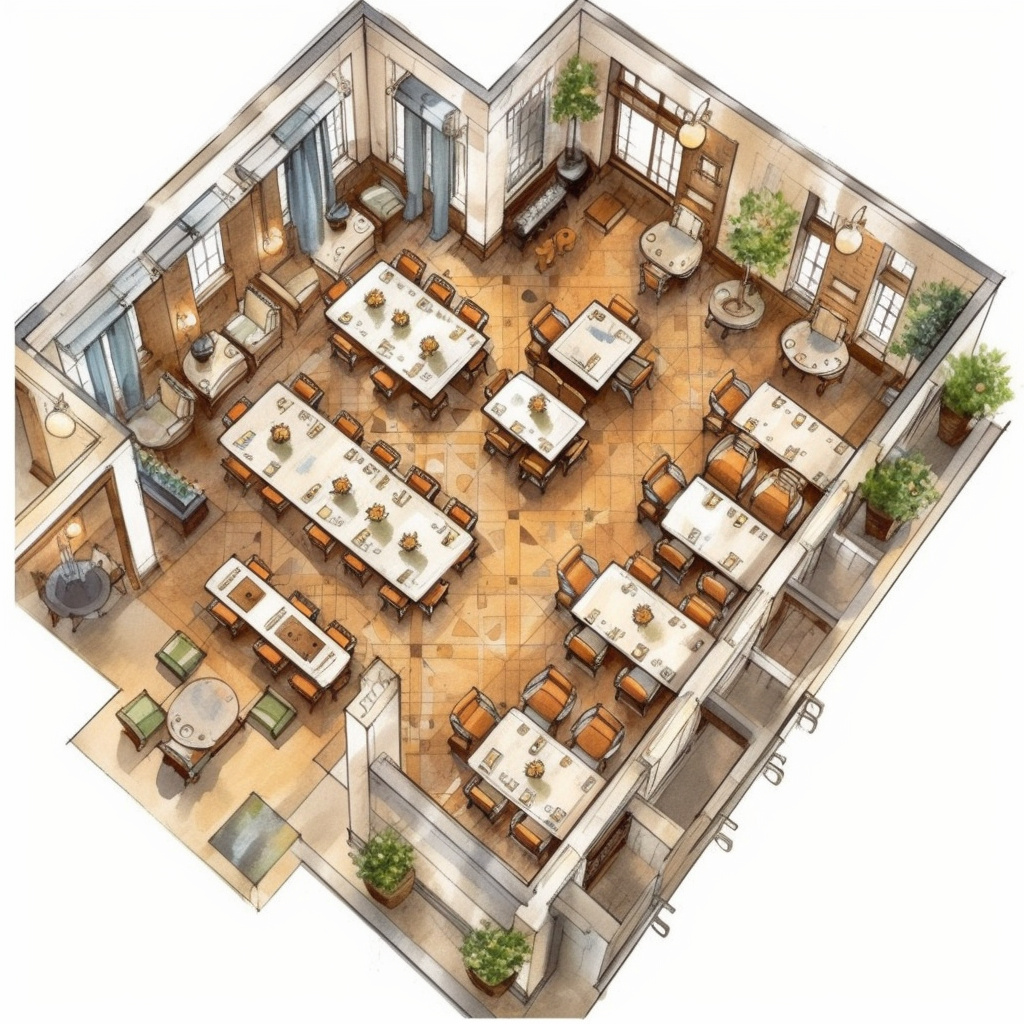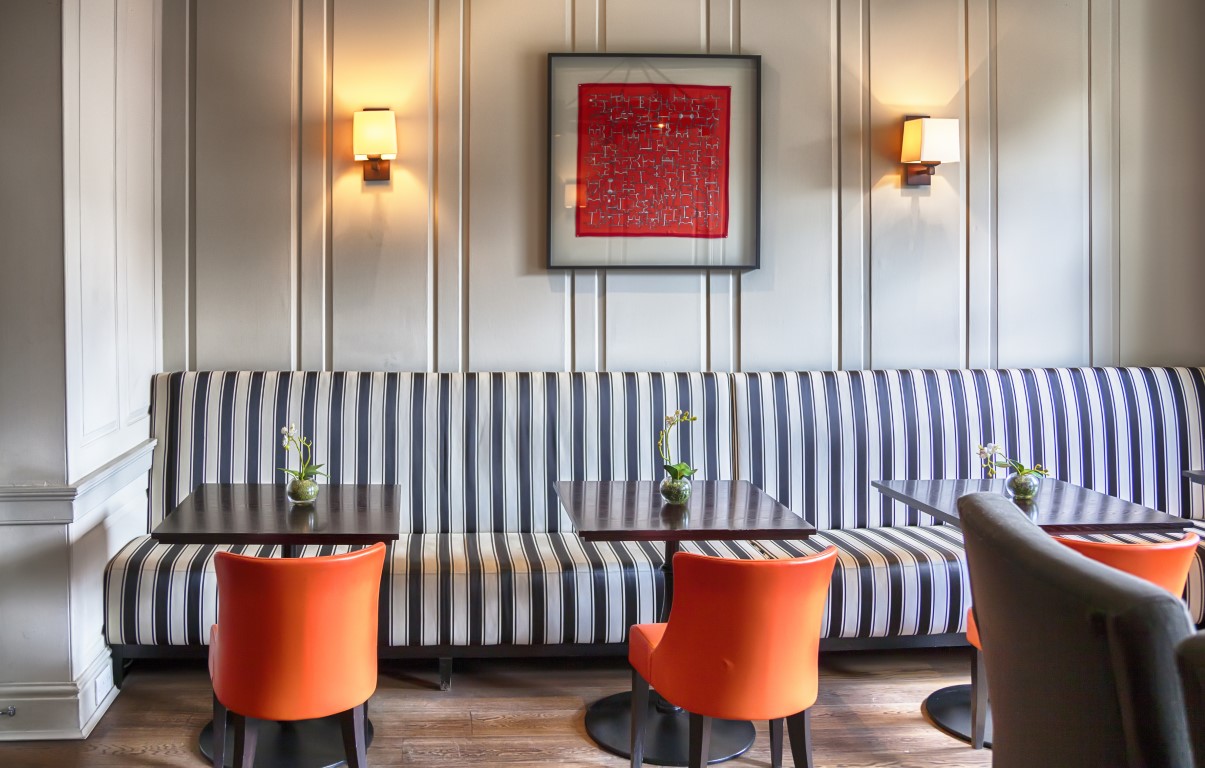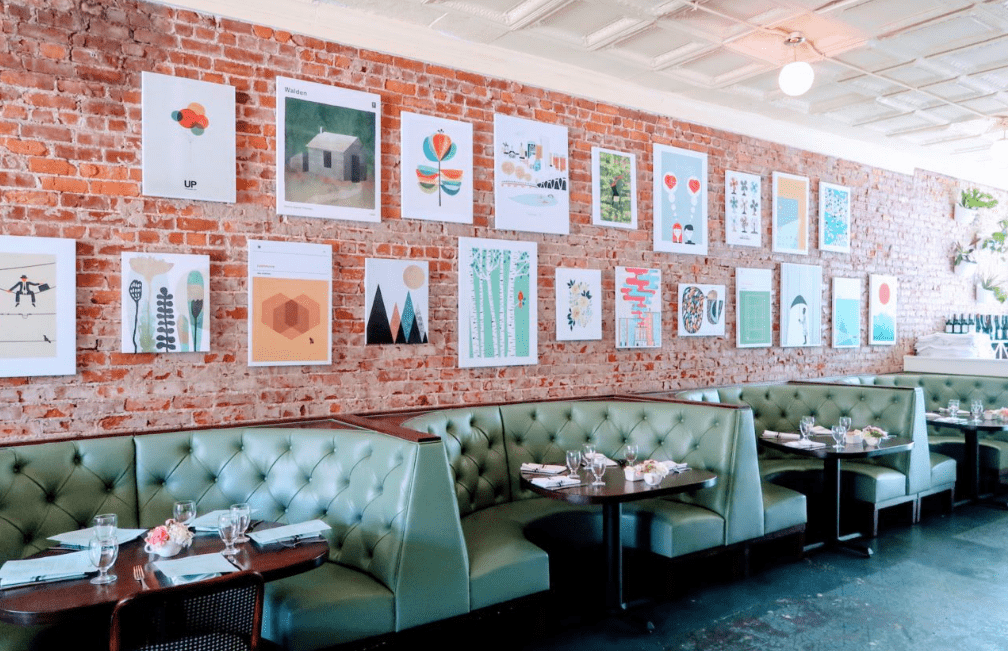Dining Room Design: Elevating Your Space for a Memorable Experience
In today's fast-paced world, the creation of an inviting and aesthetically pleasing dining room has emerged as a crucial element in establishing a memorable dining experience. At Central Seating, we recognize the significance of exceptional dining room design and its impact on attracting customers. Our team of experts has curated a comprehensive guide aimed at helping you elevate your dining room to new heights, crafting a space that stands out and leaves a lasting impression on your guests.
The Power of Ambiance: Establishing the Mood
Crafting an appealing ambiance is paramount for any successful dining establishment, as it sets the stage for the entire dining experience and plays a vital role in how customers perceive your restaurant. Here are key factors to consider when designing the perfect ambiance:
Lighting: Illuminating the Atmosphere

Lighting plays a pivotal role in setting the atmosphere of a dining room, influencing its overall mood. The careful selection of lighting fixtures and the implementation of appropriate techniques can transform an ordinary space into an extraordinary one. Let's explore the different aspects of lighting to consider:
-
Natural Light: Embracing the captivating beauty of natural light, you can strategically position windows or skylights to allow an abundance of daylight to flood your dining room. This not only creates a warm and inviting atmosphere but also makes your guests feel comfortable and relaxed. The gentle glow of natural light enhances the dining experience, connecting diners with the outside world.
-
Artificial Lighting: To create a layered effect, it is beneficial to combine ambient, task, and accent lighting in your dining room. Ambient lighting provides a general illumination to the space, ensuring visibility without being too harsh. Task lighting focuses on specific areas where activities like reading menus or writing may take place. Accent lighting draws attention to particular features, such as artwork or architectural elements.
Dimmers offer versatility, allowing you to adjust the intensity of the lighting throughout the day and evening, adapting to different dining occasions. Pendant lights, chandeliers, and wall sconces are examples of lighting fixtures that can add an elegant and sophisticated touch to your dining room, enhancing its aesthetic appeal.
By artfully blending natural light with carefully chosen artificial lighting elements, you can create a dynamic interplay of light and shadows, accentuating the ambiance of your dining space. This interplay contributes to a memorable dining experience for your guests, as the lighting enhances their perception of the surroundings and adds to the overall sensory delight.
It's important to consider the specific needs and characteristics of your dining establishment when designing the lighting scheme. By striking the right balance between natural and artificial lighting, you can create an atmosphere that not only complements your restaurant's style but also enhances the enjoyment of the dining experience.
Color Scheme: Infusing Life and Vibrancy

When it comes to restaurant interior design, the selection of colors holds immense power in influencing the overall mood and emotions experienced by your guests. By strategically infusing colors into your dining space, you can create a captivating atmosphere that enhances the overall dining experience. Let's explore how different color choices can transform your restaurant interior:
-
Warm Colors: To create a cozy and intimate ambiance that ignites excitement and appetite, consider incorporating shades of red, orange, and yellow into your dining room design. These warm hues have the ability to stimulate the senses and create a welcoming atmosphere. One effective way to introduce warm colors is through accent walls, where a deep red or vibrant orange can serve as a focal point, instantly grabbing attention and creating a sense of comfort.
-
Cool Colors: If your aim is to establish a serene and relaxed environment within your upscale dining establishment, opt for cool colors like blues, greens, and purples. These shades exude a sense of tranquility, making them ideal for creating a sophisticated atmosphere. Incorporate cool colors through elements such as wall paint, upholstery, or decorative accessories. Soft blues can evoke a calming effect, while deep greens can add a touch of elegance and freshness. Hints of purple can lend a regal and luxurious ambiance to your space.
-
Neutral Colors: For a versatile backdrop that complements various dining room styles, neutral tones such as beige, gray, and cream are your go-to options. These colors provide an elegant and timeless appeal, allowing other design elements to take center stage. By incorporating neutral colors in the walls, flooring, or furniture, you create a harmonious foundation that effortlessly blends with different decor styles and accentuates other design elements. Additionally, neutral tones can contribute to a visually spacious environment, making your dining area feel more open and inviting.
Remember, the key to successfully infusing colors into your restaurant interior is to strike a balance. Play with different intensities, shades, and combinations to achieve the desired effect. Don't be afraid to experiment with various color schemes, ensuring that they align with your brand identity and the overall dining experience you wish to create. By skillfully using colors, you can transform your restaurant into a vibrant and captivating space that leaves a lasting impression on your guests.
Furniture and Layout: Comfort and Functionality
The careful selection and arrangement of furniture are essential to creating a harmonious and functional dining space that caters to the needs of your guests. By considering various factors, you can ensure that your furniture choices enhance comfort and maximize the efficient use of space. Let's delve deeper into these aspects:
-
Comfort: To provide an exceptional dining experience, prioritize comfort when selecting seating options for your restaurant. Opt for chairs and banquettes that offer ample cushioning and are upholstered with high-quality fabrics. Comfortable seating not only allows your guests to relax and enjoy their meals for extended periods but also adds a touch of luxury to the overall ambiance. Consider incorporating elements such as padded armrests, ergonomic designs, and supportive backrests to enhance comfort levels and promote a sense of well-being.
-
Space Optimization: Efficient space utilization is crucial in creating a restaurant layout that accommodates a significant number of customers while ensuring their comfort and ease of movement. Striking a balance between seating capacity and adequate space for maneuverability is key. Assess the available area and consider the flow of traffic within your restaurant. By optimizing the layout, you can enhance the overall functionality and customer experience.
-
Designated Areas: Create designated areas to cater to different group sizes and preferences. This can include larger tables for accommodating bigger parties, intimate booths for couples seeking privacy, or bar seating for solo diners or quick meals. By offering a variety of seating options, you can cater to diverse customer needs and preferences, ensuring a personalized experience for everyone.
-
Spacing and Arrangement: Pay attention to the placement and arrangement of tables and chairs to optimize the available space. Strike a balance between maximizing seating capacity and providing enough room for guests and staff to move comfortably. Avoid overcrowding by ensuring adequate space between tables, allowing guests to have private conversations without feeling cramped. This thoughtful arrangement not only enhances comfort but also contributes to a visually appealing and organized dining environment.
-
Versatility: Consider furniture that offers versatility in terms of functionality and adaptability. Modular seating options or lightweight tables that can be easily rearranged to accommodate varying group sizes or special events provide flexibility and allow for efficient space utilization. This adaptability ensures that your dining space can easily adapt to different occasions and customer demands, maximizing its potential.
By prioritizing comfort and optimizing space utilization through thoughtful furniture selection and layout design, you can create a dining space that not only enhances the overall experience for your guests but also maximizes the operational efficiency of your restaurant. Carefully considering these factors contributes to a harmonious and functional environment that encourages guests to linger, enjoy their meals, and return for future dining experiences.
Design Elements: Enhancing Visual Appeal
Creating a visually appealing dining room goes beyond setting the right ambiance. Thoughtfully incorporating design elements can elevate the overall aesthetic and captivate your guests. Paying attention to key factors such as wall decor, flooring choices, and table settings can make a significant difference in enhancing the visual appeal of your restaurant. Let's explore these aspects in greater detail:
- Wall Decor: Unveiling a Story
Enhancing the walls of your dining room with thoughtful and engaging decor can add depth and character to the space. Consider the following options:
-
Artwork: Selecting artwork that resonates with your restaurant's theme and evokes emotions in your guests can create a captivating atmosphere. From contemporary paintings to vintage photographs or unique sculptures, art can add a personal touch and serve as a conversation starter. Choose pieces that reflect the ambiance you want to create, whether it's a modern and edgy vibe or a classic and timeless feel.
-
Wallpaper: Opting for statement wallpapers with intricate patterns or textures can transform a plain wall into a work of art. Consider designs such as botanical prints, geometric patterns, or even custom-made wallpapers that align with your restaurant's theme. Well-chosen wallpaper can serve as a striking focal point, adding visual interest and enhancing the overall atmosphere.
- Flooring: From Functional to Fashionable
The choice of flooring not only impacts the visual appeal of your dining room but also contributes to its functionality. Consider the following flooring options:
-
Hardwood: Hardwood flooring exudes elegance and sophistication, making it a popular choice for upscale dining establishments. The warm tones and natural beauty of hardwood create a welcoming atmosphere that adds a touch of luxury. Ensure you select durable wood species, such as oak or maple, that can withstand the high traffic of a restaurant while maintaining its aesthetic appeal.
-
Tile: Tiles offer versatility and durability, allowing you to explore various styles and designs. From sleek porcelain to colorful mosaic patterns, tiles can add a touch of personality to your dining room. Consider using tiles that complement your overall theme and ambiance, and prioritize slip-resistant options to ensure the safety of your guests and staff.
-
Carpeting: Carpeting can add comfort and acoustic benefits to your dining space. Choose carpets with stain-resistant and easy-to-clean properties to maintain a hygienic environment. Consider using carpet tiles for easier maintenance and greater flexibility in design. When selecting carpet colors and patterns, ensure they align with your restaurant's aesthetic and create a cohesive look.
- Table Settings: Style and Elegance
Table settings play a significant role in enhancing the visual appeal of your dining room while directly influencing the overall dining experience. Consider the following tips:
-
Tableware: Invest in high-quality tableware that complements your restaurant's theme and ambiance. From elegant fine china to rustic pottery, select pieces that reflect your brand's identity and elevate the dining experience. Pay attention to the quality of cutlery, glassware, and linens as well, as they contribute to the overall visual appeal and guests' tactile experience.
-
Centerpieces: A well-designed centerpiece can serve as a captivating focal point on each table, adding a touch of elegance and charm. Consider fresh flowers, decorative candles, or unique sculptural pieces that align with your restaurant's aesthetic. It's important to ensure that the centerpiece doesn't obstruct guests' view or hinder their ability to engage in conversation.
By carefully curating wall decor, selecting the right flooring materials, and paying attention to table settings, you can enhance the visual appeal of your restaurant's dining room. These design elements not only create a captivating atmosphere but also contribute to the overall dining experience, leaving a lasting impression on your guests and encouraging them to return for more memorable moments in your establishment
Creating an Engaging Mermaid Diagram: Ideal Dining Room Layout

When it comes to designing a restaurant's interior, the layout plays a crucial role in creating an inviting and engaging dining experience. One approach that has gained popularity in recent years is the mermaid diagram dining room layout. This unique design not only offers visual appeal but also enhances the flow and functionality of the space.
The mermaid diagram dining room layout takes inspiration from the graceful and fluid movements of a mermaid, incorporating curved lines and organic shapes throughout the space. This layout encourages a sense of exploration and discovery as guests navigate through the restaurant, creating an immersive experience that leaves a lasting impression.
To begin creating an engaging mermaid diagram dining room layout, consider the following key elements:
-
Entrance: The entrance sets the tone for the entire dining experience. Incorporate a grand entrance with an intriguing focal point, such as a captivating artwork or a cascading water feature. Use curved lines and organic shapes in the entrance design to emulate the fluidity of a mermaid's tail.
-
Seating Zones: Divide the dining room into distinct seating zones, each with its own unique ambiance. Incorporate a variety of seating options, including booths, banquettes, and freestanding tables, to accommodate different group sizes and preferences. Utilize the mermaid diagram concept by arranging seating areas in gentle curves and organic patterns, creating a dynamic and visually appealing layout.
-
Pathways and Circulation: Ensure that the pathways between seating areas are spacious and well-defined, allowing guests to navigate the space comfortably. Curved walkways mimic the elegant movements of a mermaid, adding a touch of whimsy to the overall design. Integrate eye-catching design elements along the pathways, such as decorative lighting fixtures or suspended art installations, to enhance visual interest.
-
Focal Points: Create captivating focal points throughout the dining room to draw guests' attention and spark intrigue. These focal points could include stunning chandeliers, large-scale artworks, or even aquariums with mesmerizing marine life. Placing these focal points strategically along the mermaid-inspired pathways will guide guests' gaze and enhance the overall sense of wonder.
-
Color and Texture: Incorporate a color palette that reflects the enchanting underwater world. Blues, greens, and soft neutrals can evoke a sense of tranquility and elegance. Introduce textures inspired by the ocean, such as wave-like patterns on wallpapers, textured fabrics reminiscent of sea corals, or even mosaic tiles that resemble shimmering water.
- Acoustic Design: Pay attention to the acoustic aspects of the dining room to ensure a pleasant dining experience. Incorporate materials and design elements that help absorb excessive noise, such as acoustic panels or textiles with sound-absorbing properties. This will create a comfortable and serene environment where guests can enjoy their meals without unnecessary distractions.
Remember, the key to a successful mermaid diagram dining room layout is finding a balance between functionality, aesthetics, and the whimsical nature of the concept. By incorporating graceful lines and organic shapes inspired by mermaids, along with thoughtful design elements, you can create an engaging and memorable dining experience that will leave your guests enchanted.
Conclusion: Crafting an Exceptional Dining Experience
Designing an outstanding dining room requires meticulous attention to detail, from lighting and color schemes to furniture and decor. By incorporating elements that create a captivating ambiance and visual appeal, you can distinguish your restaurant from the competition and leave a lasting impression on your guests.

